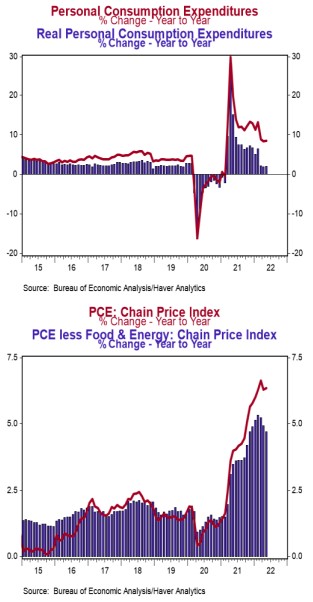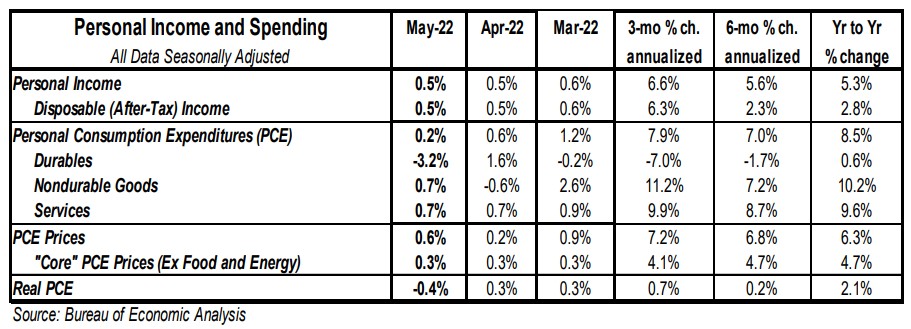- Personal income rose 0.5% in May ( 0.6% including revisions to prior months), matching consensus expectations. Personal consumption rose 0.2% in May (-0.6% including prior months' revisions), versus a consensus expected 0.4%. Personal income is up 5.3% in the past year, while spending has increased 8.5%.
- Disposable personal income (income after taxes) increased 0.5% in May and is up 2.8% from a year ago.
- The overall PCE deflator (consumer prices) rose 0.6% in May and is up 6.3% versus a year ago. The "core" PCE deflator, which excludes food and energy, rose 0.3% in May and is up 4.7% in the past year.
- After adjusting for inflation, "real" consumption declined 0.4% in May, but is up 2.1% from a year ago.
Implications:
Consumers continued to spend at a healthy pace in May, but inflation has them spending more to get less. The best news in today's report was the 0.5% rise in personal income, where private sector wages and salaries rose ( 0.6% in May) while government transfer payments fell (-0.2%). Compared to a year ago, personal income is up 5.3%, lagging the 6.3% rise in inflation of the same period. However, the headline income number hides an important transition. Strip out government transfer payments – the economic morphine that Washington used to cover up the pain of bad COVID policies – and personal income is up 8.3% in the past year, with private-sector wages and salaries up a massive 11.9% over the same period. Consumption, meanwhile, rose 0.2% in May and is up 8.5% from a year ago. Diving into the details shows a clear transition from goods toward services. While spending on services rose 0.7% in May (and are up 9.6% from a year ago), spending on goods fell 0.7% (but remains up 6.6% from a year ago). As COVID restrictions have faded, people have gotten back outside to leisure and travel activities. Since bottoming in April of 2020, consumption has grown at an astronomical 17.9% annual rate and today stands 14.7% above February 2020 levels. But artificially booming demand, the result of government transfers and rapid growth in the M2 money supply, is not a free lunch. PCE prices, the Fed's preferred measure of inflation, rose 0.6% in May, and are up 6.3% from a year ago. Core prices, which exclude food and energy, rose 0.3% in May and are up 4.7% from a year ago, neither anywhere close to the Federal Reserve's 2.0% target. In other news this morning, initial unemployment claims declined 2,000 last week to 231,000. Meanwhile, continuing claims fell 3,000 to 1.328 million. These figures are consistent with continued growth in jobs in June. On the manufacturing front, the Chicago PMI, declined to 56.0 in June from 60.3 in May.





